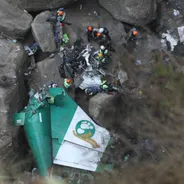"Reduce, reuse, recycle," come the cries of the eco-warriors. However, while taking a firm stance on environmental issues is still stigmatised, the effects of humankind's lax attitude towards the planet is manifesting itself in ever more concerning ways.
A sperm whale, one of the largest animals on the planet, is likely to have been defeated by the 1,000 pieces of plastic trash in its stomach. Washed ashore in an Indonesian national park, the carcass was assessed by researchers who discovered almost six kilos of plastic in its stomach.
Items discovered included 115 drinking cups, four plastic bottles, 25 plastic bags and two flip-flops. The 9.5m (31ft) creature was found near Kapota Island in the Wakatobi National Park late on Monday. The whale had to be buried without a necropsy due to its decayed condition but it's thought that the plastics in its stomach could be responsible for its death.

Zach Abraham, Director of Global Campaigns at WWF International, told VT: "This devastating discovery is a painful reminder of the impact that plastic pollution is having in our oceans and the damage it is causing to marine life. Governments and businesses must do more to prevent plastic from entering our rivers and oceans."
Last year, in addition to the news that we now cannot reverse climate change simply by planting trees, it was also reported that marine ecosystems are facing "irreparable damage". Stating that we are not in a position to fully heal our oceans might seem like a pessimistic approach. However, considering 10 million tonnes of plastic waste ends up in the world's oceans every year, it's not hard to see how the UN came to this conclusion.

In fact, in March, it was reported that a study by Foresight Future of the Sea Report had found that ocean plastic could triple in the next decade. Three months later, a pilot whale died off the southern coast of Thailand having swallowed 80 plastic bags."If nature had a distress signal to warn us that it can't take any more of our plastic rubbish," Greenpeace stated in a press release, "it would look like this - a dead whale with 1,000 pieces of plastic in its stomach. Our throwaway culture has turned whales' guts into dustbins for our plastic waste. And the global plastic contamination doesn't end there - this material is already in the food we eat, the water we drink, and inevitably in our bodies too. It's clear that we can't go on like this."

According to a German study, the majority of the plastics in the ocean come from just 10 major rivers - the Yangtze, the Indus, Yellow River, Hai River, the Nile, the Ganges, Pearl River, Amur River, the Niger, and the Mekong (in that order).There exists a clear cultural and corporate divide between east and west, with five Asian countries - China, Indonesia, the Philippines, Vietnam and Thailand - responsible for more than half of the plastic waste that ends up in our oceans. This is according to a report published in 2015 by Ocean Conservancy and the McKinsey Center for Business and Environment.
In a tweet by WWF-Indonesia, they explain just what the carcass contained: "Hard plastic (19 pieces, 140g), plastic bottles (4 pieces, 150g), plastic bags (25 pieces, 260g), flip-flops (2 pieces, 270g), pieces of string (3.26kg) & plastic cups (115 pieces, 750g)."
“This discovery is deeply upsetting," Dwi Suprapti, WWF-Indonesia Marine Species Specialist, told VT. "It is a wake-up call for Indonesians about how plastic pollution is causing irreparable damage to our oceans and marine life. We urge businesses and governments to work together to address this issue urgently to prevent further plastic leakage into our oceans."

However, there are wider implications for those who eat meat and fish. While cups and flip-flops are - of course - a huge problem, there are also 51 trillion microplastic particles in the ocean. In many cases, plastic pellets are lost before they have a chance to be manufactured into something. Often ending up in drains, streams or bags of trash destined for landfill, they regularly make their way into the ocean.
Other microplastics can be found in toothpastes, facewash and cleaning items. That said, the items in the ocean which are visibly affecting wildlife - such as carrier bags - are also eventually broken down into microplastics.

Due to the cyclical nature of the food chain, these plastics then end right back where they started - with the humans. Because of the sheer quantity of meat and fish we eat, we ingest far more microplastics than any restaurant or supermarket would have you believe.
However, as well as meat and fish products, microplastics have also been found in honey, beer and sea salt. In fact, due to the erosion of the bottle itself, bottled water may contain up to 241 microplastic particles per litre.
"If we want to stop this slow-motion environmental disaster unfolding before our eyes," Greenpeace continue, "we need to immediately start cutting the amount of throwaway plastic we produce. The change needs to take place at the source: in the supermarket aisles where so much plastic packaging is sold and in the production lines of consumer giants like Coke, Nestle and others, where our plastic problem originates."
Eating up to one tonne of food per day, sperm whales are especially at risk of ingesting plastics and are considered a vulnerable species by the IUCN (International Union for Conservation of Nature). However, living for up to 70 years and having the largest brain of any animal to have ever existed, sperm whales are in a unique position to observe the damage that the two-legged land creatures are doing to their home.
In one minute, you can take part in this Greenpeace campaign and urge major corporations to rethink their relationship with plastic.












